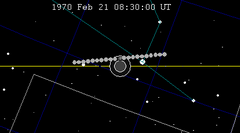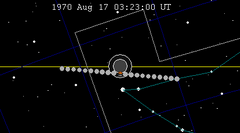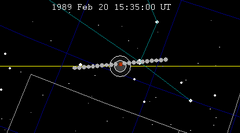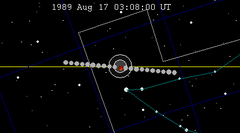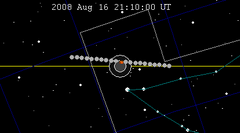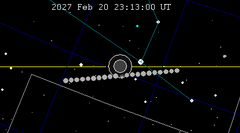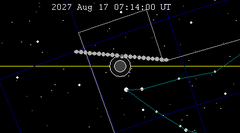
A partial lunar eclipse took place on 16 August 2008, the second of two lunar eclipses in 2008, with the first being a total eclipse on 20 February 2008. The next lunar eclipse was a penumbral eclipse occurring on 9 February 2009, while the next total lunar eclipse occurred on 21 December 2010.

A penumbral lunar eclipse took place on April 24, 2005, the first of two lunar eclipses in 2005. At maximum eclipse, 86.5% of the Moon's disc was partially shaded by the Earth, which caused a slight shadow gradient across its disc; this subtle effect may have been visible to careful observers. No part of the Moon was in complete shadow. The eclipse lasted 4 hours and 6 minutes overall, and was visible from east Asia, Australia, and the Americas.

A partial lunar eclipse took place on Monday, October 17, 2005, the second of two lunar eclipses in 2005. A tiny bite out of the Moon may have been visible at maximum, though just 6.25% of the Moon was shadowed in a partial eclipse which lasted for nearly 56 minutes and was visible over east Asia, Australasia, and most of the North America. A shading across the moon from the Earth's penumbral shadow should have been visible at maximum eclipse.

A penumbral lunar eclipse took place on 14 March 2006, the first of two lunar eclipses in 2006.
A partial lunar eclipse took place on Saturday, August 27, 1988, the second of two lunar eclipses in 1988, the first being on March 3, 1988. The Earth's shadow on the moon was clearly visible in this eclipse, with 29.159% of the Moon in shadow; the partial eclipse lasted for 1 hour, 52 minutes and 59.7 seconds. The Moon was only 5 hours and 48 minutes before perigee, making it 6.3% larger than average

A partial lunar eclipse took place on Saturday, December 21, 1991, the last of four lunar eclipses in 1991. The moon grazed the northern edge of the umbral shadow.
A penumbral lunar eclipse took place on Thursday, March 3, 1988, the first of two lunar eclipses in 1988, the second being on August 27, 1988. Earlier sources compute this as a 0.3% partial eclipse lasting under 14 minutes, and newest calculations list it as a penumbral eclipse that never enters the umbral shadow. In a rare total penumbral eclipse, the entire Moon was partially shaded by the Earth, and the shading across the Moon should have been quite visible at maximum eclipse. The penumbral phase lasted for 4 hours, 53 minutes and 50.6 seconds in all, though for most of it, the eclipse was extremely difficult or impossible to see. The Moon was 2.2 days after apogee, making it 6.1% smaller than average.

A penumbral lunar eclipse took place on Thursday, June 27, 1991, the second of four lunar eclipses in 1991. The moon entered the Earth's penumbra for about 3 hours, and was difficult to see. This lunar eclipse is the predecessor of the Solar eclipse of July 11, 1991.
A penumbral lunar eclipse took place on Thursday, November 8, 1984, the last of three lunar eclipses in 1984. This subtle penumbral eclipse may have been visible to a skilled observer at maximum eclipse. 90% of the Moon's disc was partially shaded by the Earth, which caused a gentle shadow gradient across its disc at maximum; the eclipse as a whole lasted 4 hours and 28 minutes.
A penumbral lunar eclipse took place on Tuesday, May 15, 1984, the first of three lunar eclipses in 1984. This was a deep penumbral eclipse, with the southern limb of the Moon close to the Earth's shadow.

A penumbral lunar eclipse occurred on Friday, 5 May 2023, the first of two lunar eclipses in 2023. The moon's apparent diameter was 0.1% larger than average because it occurred 5.5 days before perigee. This was the deepest penumbral eclipse since February 2017 and until September 2042.
A partial lunar eclipse will take place on Saturday, 28 October 2023.

A partial lunar eclipse will take place on Friday 28 August 2026. The moon will be almost be inside the umbra, but not quite be contained within the umbral shadow at greatest eclipse.

A penumbral lunar eclipse will take place on 20–21 February 2027.

A penumbral lunar eclipse will take place on 18 July 2027. The Moon will barely clip the edge of the Earth's penumbral shadow, and the eclipse will be impossible to see in practice. The event is listed as a miss by some sources.
A partial lunar eclipse took place on Monday, August 17, 1970, the second of two lunar eclipses in 1970, the first was on February 21 of that year. The Earth's shadow on the Moon was clearly visible in this eclipse, with 41% of the Moon in shadow; the partial eclipse lasted for 2 hours and 11 minutes. It was the second of two lunar eclipses in 1970.
A partial lunar eclipse took place on Saturday, February 21, 1970. It was the first of two partial lunar eclipses in 1970, the other being on August 17 of the same year. A tiny bite out of the Moon may have been visible at maximum, though just 5% of the Moon was shadowed in a partial eclipse which lasted for 52 minutes and 42 seconds. A shading across the moon from the Earth's penumbral shadow should have been visible at maximum eclipse.

A penumbral lunar eclipse took place on Wednesday, May 4, 1966, the first of two penumbral lunar eclipses in 1966. It was visible from South America, Europe, Africa, Asia, Australia and Antarctica.
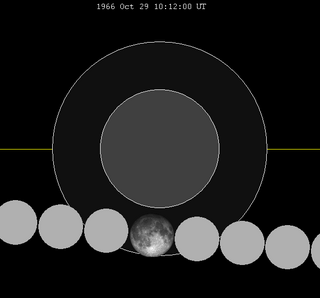
A penumbral lunar eclipse took place on Saturday, October 29, 1966, the second of two lunar eclipses in 1966. This was a deep penumbral eclipse, with over 90% within Penumbral Shadow.

A total lunar eclipse will take place on March 13, 2044.




















